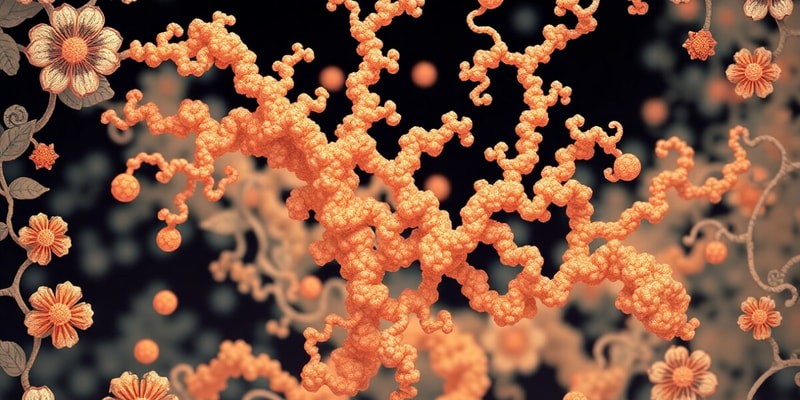Podcast
Questions and Answers
What is a zwitterion?
What is a zwitterion?
What happens to the carboxyl group of amino acids at low pH?
What happens to the carboxyl group of amino acids at low pH?
What is the charge of amino acids at high pH?
What is the charge of amino acids at high pH?
Where are amino acid transporters/carriers located?
Where are amino acid transporters/carriers located?
Signup and view all the answers
What is the function of the Na-H exchange in the luminal membrane?
What is the function of the Na-H exchange in the luminal membrane?
Signup and view all the answers
What is co-transported with dipeptides and tripeptides in the luminal membrane?
What is co-transported with dipeptides and tripeptides in the luminal membrane?
Signup and view all the answers
What type of transport is used for most amino acids?
What type of transport is used for most amino acids?
Signup and view all the answers
What is a type of antibiotic that can be transported by the peptide transporter?
What is a type of antibiotic that can be transported by the peptide transporter?
Signup and view all the answers
What is the function of the peptide transporter in the absorption of antibiotics?
What is the function of the peptide transporter in the absorption of antibiotics?
Signup and view all the answers
What type of amino acids are released by Carboxypeptidase A?
What type of amino acids are released by Carboxypeptidase A?
Signup and view all the answers
What is the primary mechanism of amino acid transport in enterocytes?
What is the primary mechanism of amino acid transport in enterocytes?
Signup and view all the answers
Where are the amino acids absorbed from in the intestine?
Where are the amino acids absorbed from in the intestine?
Signup and view all the answers
What is the role of Na+/K+ ATPase pump in amino acid transport?
What is the role of Na+/K+ ATPase pump in amino acid transport?
Signup and view all the answers
What type of transport proteins are involved in amino acid absorption?
What type of transport proteins are involved in amino acid absorption?
Signup and view all the answers
What is the purpose of the secondary transport mechanism in amino acid transport?
What is the purpose of the secondary transport mechanism in amino acid transport?
Signup and view all the answers
What type of amino acids are released by Carboxypeptidase B?
What type of amino acids are released by Carboxypeptidase B?
Signup and view all the answers
Where does the facilitated diffusion of amino acids occur?
Where does the facilitated diffusion of amino acids occur?
Signup and view all the answers
What is the location of the Na+/K+ ATPase pump in enterocytes?
What is the location of the Na+/K+ ATPase pump in enterocytes?
Signup and view all the answers
Which amino acid is classified as aromatic and nonpolar?
Which amino acid is classified as aromatic and nonpolar?
Signup and view all the answers
Which of the following amino acids is negatively-charged?
Which of the following amino acids is negatively-charged?
Signup and view all the answers
What is the characteristic of basic amino acids?
What is the characteristic of basic amino acids?
Signup and view all the answers
Which amino acid is classified as sulfur-containing and nonpolar?
Which amino acid is classified as sulfur-containing and nonpolar?
Signup and view all the answers
Which of the following amino acids is essential?
Which of the following amino acids is essential?
Signup and view all the answers
Which amino acid is classified as hydroxyl-containing and polar?
Which amino acid is classified as hydroxyl-containing and polar?
Signup and view all the answers
Which of the following amino acids is non-essential?
Which of the following amino acids is non-essential?
Signup and view all the answers
What is the characteristic of acidic amino acids?
What is the characteristic of acidic amino acids?
Signup and view all the answers
Which of the following amino acids is classified as aromatic and polar?
Which of the following amino acids is classified as aromatic and polar?
Signup and view all the answers
What is the effect of a defect/mutation in the 6th position of hemoglobin in sickle cell disease?
What is the effect of a defect/mutation in the 6th position of hemoglobin in sickle cell disease?
Signup and view all the answers
What is the substitution in sickle cell hemoglobin?
What is the substitution in sickle cell hemoglobin?
Signup and view all the answers
What is a conservative replacement/mutation/substitution?
What is a conservative replacement/mutation/substitution?
Signup and view all the answers
What is the result of the substitution of glutamic acid with valine in sickle cell hemoglobin?
What is the result of the substitution of glutamic acid with valine in sickle cell hemoglobin?
Signup and view all the answers
What is the effect of low oxygen levels in the blood on hemoglobin in sickle cell disease?
What is the effect of low oxygen levels in the blood on hemoglobin in sickle cell disease?
Signup and view all the answers
Is the substitution of glutamic acid for valine in sickle cell hemoglobin a conservative replacement?
Is the substitution of glutamic acid for valine in sickle cell hemoglobin a conservative replacement?
Signup and view all the answers
What is the result of sickling of red blood cells?
What is the result of sickling of red blood cells?
Signup and view all the answers
What is the normal amino acid in the 6th position of hemoglobin?
What is the normal amino acid in the 6th position of hemoglobin?
Signup and view all the answers
What happens to hemoglobin molecules when oxygen levels in the blood are low in sickle cell disease?
What happens to hemoglobin molecules when oxygen levels in the blood are low in sickle cell disease?
Signup and view all the answers
What is the initial charge of the amino acid when the pKa is below 2.01?
What is the initial charge of the amino acid when the pKa is below 2.01?
Signup and view all the answers
What is the charge of the amino acid when the first pKa value is reached?
What is the charge of the amino acid when the first pKa value is reached?
Signup and view all the answers
What is the charge of the amino acid when the second pKa value is reached?
What is the charge of the amino acid when the second pKa value is reached?
Signup and view all the answers
What is the charge of the amino acid when the third pKa value is reached?
What is the charge of the amino acid when the third pKa value is reached?
Signup and view all the answers
What is the correct sequence of charges for Arginine?
What is the correct sequence of charges for Arginine?
Signup and view all the answers
What is the purpose of the shortcut for the charges of amino acids?
What is the purpose of the shortcut for the charges of amino acids?
Signup and view all the answers
What is the rule for acidic and basic amino acids?
What is the rule for acidic and basic amino acids?
Signup and view all the answers
How do you determine the pI of an amino acid?
How do you determine the pI of an amino acid?
Signup and view all the answers
What is the charge of glutamic acid at pH 3.2?
What is the charge of glutamic acid at pH 3.2?
Signup and view all the answers
Study Notes
Amino Acid Chemistry
- Amino acids can exist as zwitterions, a state with no net charge, with both positive and negative charges.
- At low pH, the carboxyl group of amino acids is protonated (-COOH), making them positively charged.
- At high pH, the alpha-amino group of amino acids is deprotonated (NH2), making them negatively charged.
Amino Acid Transporters
- Amino acid transporters are located in the apical brush border membrane of epithelial cells.
- These carriers have overlapping specificity for different amino acids.
- There are transporters for:
- Neutral amino acids
- Proline and hydroxyproline
- Acidic amino acids
- Basic amino acids (lysine, arginine, ornithine) and cystine
- Most amino acids are transported by more than one transport system.
Dipeptides and Tripeptides Transport
- Dipeptides and tripeptides are co-transported by the H+ in the luminal membrane.
- An electrochemical gradient is established by Na-H exchange, powered by Na-K ATPase pump.
- The peptide transporter also accepts beta-lactam antibiotics.
Exopeptidases
- Exopeptidases are zinc peptidases that remove amino acids from the carboxyl end of a polypeptide chain.
- Carboxypeptidase A releases hydrophobic amino acids (val, leu, ile, ala).
- Carboxypeptidase B releases basic amino acids (arg, lys).
Protein Digestion and Absorption
- Digested amino acids are absorbed by enterocytes principally by semi-specific Na+-dependent transport proteins.
- The primary transport mechanism is the creation of a Na+ gradient, driven by the pumping of Na+ out of the cell by a Na+, K+-ATPase pump.
- The secondary transport mechanism is the coupling of amino acids to the influx of sodium, allowing the cell to concentrate amino acids from the intestinal lumen.
Amino Acid Classification
- Aromatic amino acids:
- Nonpolar: tryptophan, phenylalanine
- Polar: tyrosine
- Basic amino acids:
- Positively-charged: lysine, arginine, histidine
- Acidic amino acids:
- Negatively-charged: aspartic acid, glutamic acid
- Amino acids containing an amide group:
- Asparagine, glutamine
- Essential and non-essential amino acids
- Essential: phenylalanine, valine, tryptophan, threonine, isoleucine, methionine, lysine, leucine
- Non-essential: alanine, asparagine, aspartate, cysteine, glutamate, glutamine, glycine, proline, tyrosine, serine
Sulfur-Containing Amino Acids
- Polar: cysteine
- Nonpolar: methionine
Hydroxyl-Containing Amino Acids
- Serine, threonine, and tyrosine
Studying That Suits You
Use AI to generate personalized quizzes and flashcards to suit your learning preferences.



